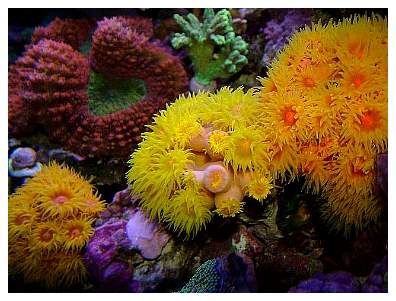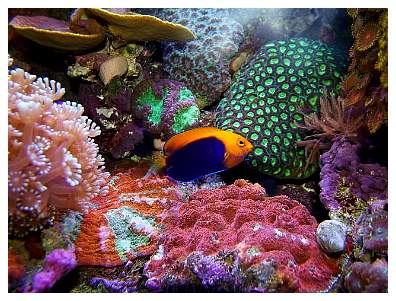|
Ollie Friend's (olliereefer) Reef
Aquarium
Introduction:
I started reefkeeping
in 1995 when I bought a 5' x 10" x 18" tank. I set
it up the way a marine center shop assistant told me, and
there's not much more to say than that it didn't last long!
I tried to take the cheap route with equipment and thought
that I could stock the tank with any fish or corals that I
liked. Not realizing the full implications of this, I learned
my lesson the hard way. After this slightly disastrous episode
I decided to give up for awhile until I had enough time to
research the hobby more carefully and in more detail (and
also to save up some more cash).
 |
I'm glad to say that after eight years, lots of books, Internet
forums (Reef Central & UltimateReef, et al) and
long afternoons bending my local shop owners' ears, Danny
& Mark @ Watford Aquariums & Paul @ Maidenhead Aquatics
(or anyone who was willing to share their knowledge), I feel
as though I've come a long way since my beginner days! I must
admit I do annoy the missus when a marine life program comes
on TV and I name all the corals and fish.
Current Tank:
The tank is a Seabray 3' L x 2' H
x 2' D aquarium with a glass & black plastic comb box
weir (overflow) in the right rear of the tank. The total volume
is approximately 427 liters (112 gallons), including the sump.
The tank was drilled and "Durso" style standpipes
were installed to minimize the noise level. Size was definitely
an issue due to the limited amount of space in the house,
so I went for a 2' tall tank and an 20" high water top-off
tank that fits snugly beside it.
After trawling around cabinet shops for a perfect stand I
was horrified by the prices they were charging, so I eventually
decided to build one myself. I used a timber frame (2' x 2')
with an 18mm medium density fiberboard top fabricated in stainless
steel for a smarter look. I managed to do all this for under
£60.00!!!
Plumbing, Filtration & Circulation:
The sump is housed in the cabinet
below the main display tank and contains approximately 87
liters (23 gallons). The first steps in plumbing were to plumb
the weir box through the top of the cabinet using 32mm pipes.
I then decided to fit a Fluval 204 (taken from my old system),
using a spraybar pointed at an angle from the top to the bottom
of the tank and returning it to the canister filter, which
is used only for carbon. All of the normal foam filters were
removed from the Fluval to prevent detritus buildup. This
line then returns to the sump. The idea for the spraybar came
to me as I realized the weir box appears to collect debris
only from the water's surface. I then added a Phosban reactor
(phosphate remover) as a precaution in case any phosphates
appear.
Cooling/Heating:
|
|
One
30-watt fan (for sump) |
|
|
Room
air conditioning unit (summer only) |
|
|
300-watt
heater |
|
|
|
A Tunze water level controller was installed in the sump
with sensors and was plumbed into the water top-off reservoir
with 20mm piping. I plumbed the skimmer using a valve to control
the pump's output. Another Eheim 1260 is used for the main
return pump (with an additional control tap) to the display,
and it's plumbed with 32mm pipe and connected to a Vecton
25-watt UV unit using soft pipe from the UV to the main display.
To direct the flow into the tank I used 20mm piping entering
at the tank's surface to cause a nice ripple action. I wanted
the tank to have good water movement and circulation, as the
live rock is my main source of filtration. I used a Tunze
Turbelle 4002 (62 l/min) with a single Tunze 7091 controller
with Hydor bio flow deflector (which gave me the advantage
of pulsing the power). I went for this option because it was
cost effective and luckily, it fit my set up beautifully.
It also doesn't take up much room, because the Turbelle's
motor is located above the water level. For additional circulation
I added a Newjet 800 powerhead.
Water
Parameters:
|
|
Temperature:
25 - 26° C |
|
|
Specific
Gravity: 1.026 |
|
|
pH:
8.1 - 8.3 |
|
|
Alkalinity:
10.0 dKH |
|
|
Calcium:
410 - 430 ppm |
|
|
Phosphate:
0 |
|
|
Nitrate:
0 |
|
|
|
Water changes are performed using a separate cube, which
holds up to 50 liters of water and contains a 300-watt heater
and a powerhead with airline attached. Reverse osmosis water
is supplied from my local fish store where it's purified with
an 8-stage R/O unit - this is also used for top-off which
I dose with calcium supplements (Kent Marine) as needed. I
mix my salt solution (Reef Crystals) in the ratio of 2lbs.
4oz. per 25 liters for a minimum of 24 hours. The water's
pH, temperature and specific gravity are checked to bring
its parameters in line with the main tank's before pumping
it out of the reservoir with an Eheim 1060 pump.
Filtration:
|
|
~80
Kilos of grade A live rock |
|
|
¾"
live sand bed (fine substrate) |
|
|
Phosban
reactor (phosphate remover) |
|
|
25-watt
ultraviolet sterilizer |
|
|
Fluval
204 canister filter (used for carbon
only); all filter pads removed |
|
|
Schuran
Jetskim 150 protein skimmer powered
by an Eheim 1260 pump |
|
|
|
Lighting Plan:
Lighting
& Photoperiod:
|
|
Three
14K marine white 39-watt T5 tubes |
9:00am
- 9:00pm |
|
|
Two
Coral Star 30-watt actinic tubes |
8:30am
- 9:30pm |
|
|
|
When planning the lighting scheme
I knew I would be housing mainly large-polyped stony corals,
most of which I know don't require very intense lighting.
This is also economical for me by keeping the electricity
bills down. I decided to use three 39-watt 14K Marine White
T5 tubes (which are lit from 9:00am-9:00pm) and two Blue Coral
Star 30-watt actinic tubes (which are lit from 8:30am-9:30pm).
I chose Arcadia Marine White 14K bulbs as I find this degree
of lighting really shows the corals off beautifully and seems
to provide an aesthetically pleasing mix. The actinic tubes
are replaced every six months without fail. My hood is split
approximately 1/3 from the rear of the tank; beneath the lid
I attached two blue tubes with Arcadia reflectors and then
I strategically placed two white and the other blue tube at
the rear. This is really handy as it gives enough space to
easily get into the top of my tank. The tubes are approximately
4" above the water's surface and there is plenty of ventilation
at the rear of the tank to ensure that the temperature stays
down.
Setup Process:
In December 2004 I had a friend who
begrudgingly was giving up the hobby, so I took the opportunity
to buy his live rock, live sand and water. I transferred it
all into my tank (luckily for me he lived only five minutes
from my house) and then started the arduous task of testing
the water for nitrates. I also did a few large water changes.
After about a month of consistent and healthy water conditions,
I decided to think about what hardy corals I was going to
add to the tank to get my reef going.
Once the live rock and sand were in place and well-established
and the initial algae bloom phase had passed, I started deliberating
on which corals to add. After much research, advice and visits
to my local marine shops, I decided. Obviously, as you can
see by the tank's specifications, a lot of the corals I possess
are very hard to come by in the UK. It's taken quite a long
time to obtain these beautiful specimens. I started adding
my fish after about three months from a carefully planned
list I'd created while carefully considering the tank's size,
the chosen fishes' adult size and their compatibility.
 |
I've added new corals and fish slowly over a period of a
year-and-a-half, and to this day my tank is running superbly,
suffering no ill effects to speak of (fingers crossed). However,
it's not been all smooth sailing - I've lost a few inhabitants,
namely my blue cheek goby and a couple of shrimps, to a greedy
boxing shrimp. The only problem I currently face is that my
corals are starting to outgrow my tank!!! I hope to upgrade
to a larger 6' tank in the very near future.
At this stage in my reefkeeping "career" I'm quite
surprised just how successfully a healthy tank can be kept
using just a basic system (who says you need gadgets and gizmos?)!
Maintenance & Feeding:
Typically, 25 liter water changes
are performed once a week with R/O water using Reef Crystals
salt; liquid calcium is dosed into the R/O top-off water when
needed. The skimmer, pumps, sump, etc. are cleaned approximately
every two months (totally stripped). All usual tests (phosphate,
nitrate, mag/alk) are carried out every other week using Salifert
test kits.
My feeding regime usually consists of two cubes of Mysis/brine
shrimp added daily with additional flake food, Cyclop-eeze
and phytoplankton. Many of the corals are target fed with
sliced silversides.
Inhabitants:
Corals:
2 - Trachyphyllia geoffroyi
3 - Scolymia spp.
3 - Acanthastrea lordhowensis
Echinophyllia sp.
Acanthastrea echinata (rainbow)
Ricordea florida
Ricordea yuma (various colors)
Rhodactis spp.
Blastomussa spp. (various)
Blastomussa merletti
Tubastrea aurea
Favia sp.
Hydnophora rigida
Acropora spp.
Stylophora sp.
Seriatopora sp.
Maze coral (Platygyra sp.)
Trumpet coral (Caulastrea sp.)
Red Brain coral (Symphyllia valenciennesii)
Chili coral (Nephthyigorgia sp.)
Zoanthids (various colors)
Goniopora sp.
Sulphur coral (Sarcophyton spp.)
2 - Plate corals (Fungia sp.)
Bubble coral (Plerogyra sinuosa)
Branching Hammer coral (Euphyllia parancora)
Branching Frogspawn coral (Euphyllia divisa)
Leather coral
And more…
|
|
|
 |
Fish:
Banana wrasse (Halichoeres
leucoxanthus)
Psychedelic mandarinfish (Synchiropus picturatus)
Orchid dottyback (Pseudochromis fridmani)
False Percula clownfish (Amphiprion ocellaris)
Anthias (Pseudanthias squamipinnis)
Scooter blenny (Synchiropus stellatus)
Fireball dwarf angel (Centropyge acanthops)
|
|
|
Invertebrates:
3 - Ceranthidae sp. anemones
Fromia sp. starfish
Maxima clam (Tridacna maxima)
Coco worm (Protula bispiralis)
Sally Lightfoot crab (Percnon gibbesi)
6 - Brittle Stars (Ophiomastix spp.)
17" Tiger Tail sea cucumber (Holothuria
thomasi)
Boxing shrimp (Stenopus hispidus)
Blood shrimp (Lysmata debelius)
Sexy shrimp (Thor amboinensis)
Sea squirt
Various hermit crabs and snails
|
|
|
Acknowledgements:
Special thanks are extended to Reef
Central for nominating me for Tank of the Month - it's a real
honor!! Thanks also to everyone who has answered my questions
and helped out. And a VERY special thanks to Danny & Marc
@ Watford Aquarium, and Paul @ Maidenhead Aquatics, for being
so knowledgeable and willing to help me to get this far in
this amazing hobby!!!
Feel free to comment
or ask questions about my tank in the Tank of the Month thread
on Reef Central.
|
If you'd like
to nominate a tank for Tank of the Month, click here
or use the button to the right.
|
 |
|

